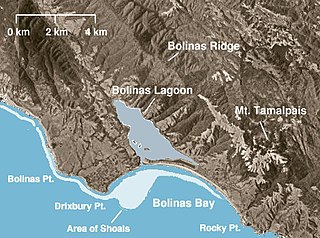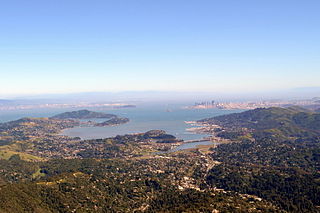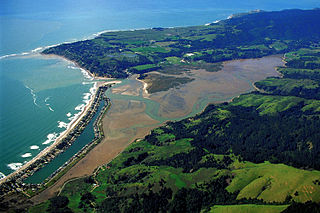See also
- Cosco Busan oil spill
- List of oil spills
- John Francis, an environmentalist whose career began with the spill
The 1971 San Francisco Bay oil spill occurred when two Standard Oil Company of California tankers, the Arizona Standard and the Oregon Standard, collided on January 18, 1971, in the San Francisco Bay. The resulting 800,000-gallon spill, the largest in Bay Area history, threatened sensitive natural habitats both inside and outside the bay, including the Bolinas Lagoon, and contributed to the growth of activism against pollution, after thousands of Bay Area residents volunteered to clean up beaches and rescue oil-soaked birds. Several environmental organizations had their origins in the spill cleanup. Standard Oil spent more than $1 million on the clean-up. [1] [2] [3] [4]
In March 1971, California's Fish and Game Department estimated that 7,000 birds were oiled during the incident, most of which died before collection or while being taken care of. At the end of January 1971, roughly 200 of the 1,600 birds "brought in" were still alive. [5] Ultimately less than 80 of those survived. [6]
The resulting environmental destruction from the spill, specifically the avian population, prompted volunteers to rescue some 4,300 birds. At the time, knowledge on how to care for oiled birds was low. Despite best efforts, only 300 or so animals were deemed fit to be released. The remnants of this volunteer force eventually resulted in the creation of the International Bird Rescue to increase knowledge and research in bird rescue. [3] One of the largest volunteer turnouts since the 1906 San Francisco earthquake came of this event. [4]

Bolinas is an unincorporated coastal community and census-designated place in Marin County, California, United States. As of the 2020 census it had a population of 1,483. It is located on the California coast, approximately 13 miles (21 km) northwest of San Francisco, and 27 miles (43 km) by road.

Bolinas Bay is a small bay, approximately 5 miles (8 km) long, on the Pacific coast of California in the United States. It is in Marin County, north of the Golden Gate, approximately 15 miles (25 km) northwest of San Francisco. The town of Bolinas is at its shore.

Bolinas Lagoon is a tidal estuary, approximately 1,100 acres (4.5 km2) in area, located in the West Marin region of Marin County, California, United States, adjacent to the town of Bolinas. It is a part of the Greater Farallones National Marine Sanctuary. In 1974, Aubrey Neasham and William Pritchard wrote in support of Bolinas Lagoon as Drake's New Albion landing site.
The MV Sea Empress was a single-hull Suezmax oil tanker that ran aground at the entrance to the Milford Haven harbour on the southwest coast of Wales in February 1996. The ensuing oil spill, Britain's third largest oil spillage and the 12th largest in the world at the time, devastated a considerable area of local coastline and killed many birds, and continued to affect the Pembrokeshire coast for years afterwards.

Richardson Bay is a shallow, ecologically rich arm of San Francisco Bay, managed under a Joint Powers Agency of four northern California cities. The 911-acre (369 ha) Richardson Bay Sanctuary was acquired in the early 1960s by the National Audubon Society. The bay was named for William A. Richardson, early 19th century sea captain and builder in San Francisco. It contains both Strawberry Spit and Aramburu Island.

Miller/Knox Regional Shoreline is a 295-acre (1.19 km2) bayside park near the Brickyard Cove neighborhood of the Point Richmond District in Richmond, California.

Wilkins Gulch is a valley in western Marin County, California, United States, located northwest of Pike County Gulch. It is associated with a small stream.
Pike County Gulch is a coastal valley in Marin County, California, United States, which is associated with a small stream. It is located between Wilkins Gulch and Audubon Canyon.
Audubon Canyon Ranch (ACR) is a 501(c)(3) not-for-profit environmental conservation and education organization headquartered in Stinson Beach, Marin County, California, on the eastern shore of Bolinas Lagoon. The lands upon which ACR operates are within the ancestral territories of the Coast Miwok, Southern Pomo and Wappo peoples. ACR recognizes that Indigenous communities are very much alive today and striving to protect and maintain relationships with cultural and natural resources on ACR lands; they acknowledge that Indigenous lands are occupied by them and others.

Morses Gulch is a coastal valley in Marin County, California, United States.
McKinnan Gulch is a valley in Marin County, California, United States.

Stinson Gulch is a valley in Marin County, California, United States which is associated with a small stream.

Bolinas Ridge is a north-south ridge in southwestern Marin County, California. Much of the western side of the ridge is protected parkland in the Golden Gate National Recreation Area, and the eastern side is watershed lands of the Marin Municipal Water District.

The Cosco Busan oil spill occurred at 08:30 UTC-8 on 7 November 2007 between San Francisco and Oakland, California, in which 53,569 US gal (202,780 L) of IFO-380 heavy fuel oil, sometimes referred to as "bunker fuel", spilled into San Francisco Bay after the container ship Cosco Busan, operated by Fleet Management Limited struck Delta Tower of the San Francisco–Oakland Bay Bridge in thick fog.
International Bird Rescue is a nonprofit organization that rehabilitates injured aquatic birds, most notably seabirds affected by oil spills. Founded by Alice Berkner and members of the Ecology Action, including veterinarian James Michael Harris, D.V.M. in 1971 and based in Cordelia, California, the group has developed scientifically-based bird rehabilitation techniques and has led oiled wildlife rescue efforts in more than 200 oil spills worldwide, including the 1989 Exxon Valdez oil spill in Prince William Sound, Alaska, and the 2010 Deepwater Horizon oil spill in the Gulf of Mexico, where International Bird Rescue co-managed oiled bird rehabilitation efforts in four states with Tri-State Bird Rescue and Research.
The MV Treasure oil spill occurred on 23 June 2000, when the ship sank six miles off the coast of South Africa while transporting iron ore from China to Brazil. The ship was carrying an estimated 1,300 tons of fuel oil, some of which spilled into the ocean, threatening the African penguin populations living on nearby islands. Cleanup efforts began promptly after the incident with particular attention being paid to salvaging the penguin communities.
The MT Castillo de Bellver oil spill began on 6 August 1983, when the Spanish tanker caught on fire off Saldanha Bay, approximately 70 miles northwest of Cape Town, South Africa. It was carrying 250,000 tonnes of light crude oil, and was traveling through an environmentally sensitive area known for its seabird rookeries and important commercial fishing grounds. The burning vessel was abandoned and broke apart after drifting offshore. Three crew were lost. The stern capsized and sunk and the bow was sunk using explosives. A total of 145,000-170,000 tonnes of oil entered the sea. Onshore impacts were considered negligible as the slick traveled seaward. The only visible impact was the oiling of 1,500 gannets that were on a nearby island.

Aramburu Island is a 17-acre (6.9 ha) island in Richardson Bay, Marin County, California. It, along with Strawberry Spit, came to exist in the 1950s and 1960s as a consequence of dumping dredged material from nearby developments into the bay. In the 1980s, the northern part of the landmass was cut off from Strawberry Spit on the directions of a Marin County supervisor to prevent housing from being constructed there, creating Aramburu Island. While natural erosion processes caused it to shrink slowly over the course of subsequent decades, a 2010s restoration effort added large amounts of material to prevent further erosion, and turned it into "sustainable bird habitat".
Golden Gate Bird Alliance is an American 501(c)(3) non-profit environmental organization engaged in bird conservation and environmental awareness. Located in the David Brower Center in Berkeley, California, Golden Gate Bird Alliance was formed in 1917 and incorporated into the National Audubon Society in 1948. With 3586 members and supporters, Golden Gate Bird Alliance spans Northern California, with a particular focus on San Francisco County, West Alameda County, and West Contra Costa County.

Lighter Wharf was a pier-wharf in Bolinas, California in Marin County built in the 1850s. Lumber was loaded onto barges (lighters), then towed through Bolinas Lagoon to deeper water in the Bolinas Bay's, Pacific Ocean and loaded onto ships. Most of the Lumber was taken to the growing city of San Francisco, due to the California Gold Rush. Most of the lumber was logged from West Marin. Bolinas Port also serviced as a port for travelers to Marin County. In the summer the lighters had to time travel through the Bolinas Lagoon with the high tide. In addition to cargo and passenger piers, Bolinas Lagoon also had a few shipyards. There are no remains of the piers and wharves in Bolinas Lagoon. The Lighter Wharf was at the northern point of Bolinas Lagoon on the western bank. The site of Lighter Wharf is a California Historical Landmark No. 221. The Lagoon is now the 1,077-acre Bolinas Lagoon Nature Preserve with millions of shorebirds, Pacific Flyway birds, harbor seals, and other wildlife.
{{cite news}}: CS1 maint: numeric names: authors list (link)